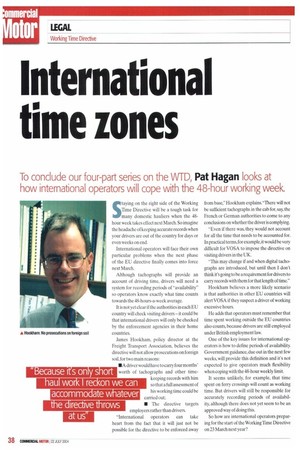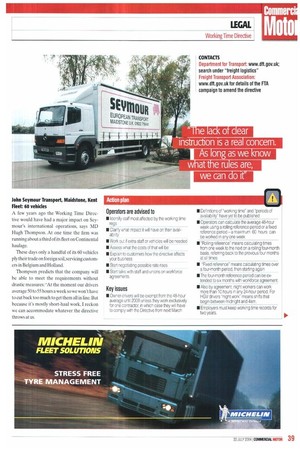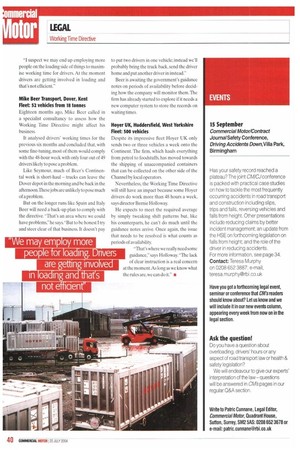Internationa 1 time zones
Page 40

Page 41

Page 42

If you've noticed an error in this article please click here to report it so we can fix it.
To conclude our four-part series on the VVTD, Pat Hagan looks at
how international operators will cope with the 48-hour working week.
Staying on the right side of the Working Time Directive will be a tough task for many domestic hauliers when the 4.8hour week takes effect next March. So imagine the headache of keeping accurate records when your drivers are out of the country for days or even weeks on end.
International operators will face their own particular problems when the next phase of the EU directive finally comes into force next March.
Although tachographs will provide an account of driving time, drivers will need a system for recording periods of "availability" so operators know exactly what time counts towards the 48-hours-a-week average.
It is not yet clear if the authorities in each EU country will check visiting drivers — it could be that international drivers will only be checked by the enforcement agencies in their home countries.
James Hookham, policy director at the Freight Transport Association, believes the directive will not allow prosecutions on foreign soil, for two main reasons: • A driver would have to carry four months' worth of tachographs and other timekeeping records with him so that a full assessment of his working time could be carried out; • The directive targets employers rather than drivers.
"International operators can take heart from the fact that it will just not be possible for the directive to be enforced away from base," Hookham explains."There will not be sufficient tachographs in the cab for, say, the French or German authorities to come to any conclusions on whether the driver is complying.
"Even if there was, they would not account for all the time that needs to be accounted for. In practical terms,for example, it would be very difficult for VOSA to impose the directive on visiting drivers in the. UK.
"This may change if and when digital tachographs are introduced, but until then I don't think it's going to be a requirement for drivers to carry records with them for that length of time."
Hookham believes a more likely scenario is that authorities in other EU countries will alert VOSA if they suspect a driver of working excessive hours.
He adds that operators must remember that time spent working outside the EU countries also counts, because drivers are still employed under British employment law.
One of the key issues for international operators is how to define periods of availability. Government guidance, due out in the next few weeks, will provide this definition and it's not expected to give operators much flexibility when coping with the 48-hour weekly limit.
It seems unlikely, for example, that time spent on ferry crossings will count as working time.. But drivers will still be responsible for accurately recording periods of availability, although there does not yet seem to be an approved way of doing this.
So how are international operators preparing for the start of the Working Time Directive on 23 March next year? John Seymour Transport, Maidstone, Kent Fleet: 60 vehicles A few years ago the Working Time Directive would have had a major impact on Seymour's international operations, says MD Hugh Thompson. At one time the firm was running about a third of its fleet on Continental haulage.
These days only a handful of its 60 vehicles ply their trade on foreign soil,servicing customers in Belgium and Holland.
Thompson predicts that the company will be able to meet the requirements without drastic measures: "At the moment our drivers average 50 to 55 hours a week so we won't have to cut back too much to get them all in line. But because it's mostly short-haul work, I reckon we can accommodate whatever the directive throws at us. "I suspect we may end up employing more people on the loading side of things to maximise working time for drivers. At the moment drivers are getting involved in loading and that's not efficient."
Mike Beer Transport, Dover, Kent Fleet: 52 vehicles from 18 tonnes Eighteen months ago, Mike Beer called in a specialist consultancy to assess how the Working Time Directive might affect his business.
It analysed drivers' working times for the previous six months and concluded that, with some fine-tuning, most of them would comply with the 48-hour week with only four out of 49 drivers likely to pose a problem.
Like Seymour, much of Beer's Continental work is short-haul — trucks can leave the Dover depot in the morning and be back in the afternoon.These jobs are unlikely to pose much of a problem.
But on the longer runs like Spain and Italy Beer will need a back-up plan to comply with the directive. "That's an area where we could have problems," he says. "But to be honest !try and steer clear of that business. It doesn't pay to put two drivers in one vehicle; instead we'll probably bring the truck back , send the driver home and put another driver in instead."
Beer is awaiting the government's guidance notes on periods of availability before deciding how the company will monitor them. The firm has already started to explore if it needs a new computer system to store the records on waiting times.
Hoyer UK, Huddersfield, West Yorkshire Fleet: 500 vehicles Despite its impressive fleet Hoyer UK only sends two or three vehicles a week onto the Continent. The firm, which hauls everything from petrol to foodstuffs, has moved towards the shipping of unaccompanied containers that can be collected on the other side of the Channel by local operators.
Nevertheless, the Working Time Directive will still have an impact because some Hoyer drivers do work more than 48 hours a week, says director Bernie Holloway.
He expects to meet the required average by simply tweaking shift patterns but, like his counterparts, he can't do much until the guidance notes arrive. Once again, the issue that needs to be resolved is what counts as periods of availability.
"That's where we really need some guidance," says Holloway. "The tack of clear instruction is a real concern at the moment.As long as we know what the rules are, we can do it." •






























































































































































































